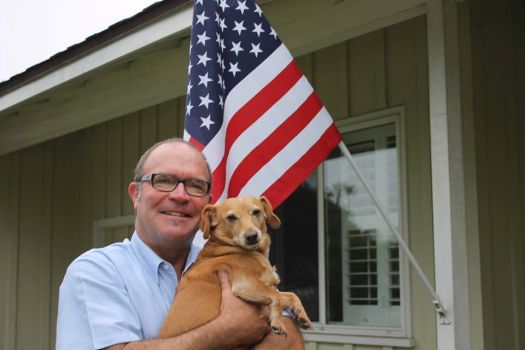Redondo Beach veterinarian Dirk Yelinek and his dog, Mary. Yelinek was elected as president of the California Veterinary Medical Association in the midst of the pandemic.
When the coronavirus pandemic struck, Redondo Beach veterinarian Dirk Yelinek suddenly found himself with a lot of lives to be concerned with.
Yelinek, a vet with more than 30 years experience, assumed the presidency of the Sacramento-based California Veterinary Medical Association just as the shelter-in-place order went into effect. In the past several months, he’s been juggling the needs of his own family, his employees, his clients and patients and the well-being of more than 7,000 veterinarians in California.
It’s been tough, as vets scrambled to keep their practices going. Some didn’t survive those first lean months, and with the temporary closure of universities and veterinarian schools, the state may be looking at a future veterinarian shortage.
We spoke to Yelinek about the struggles he and other vets have faced and what the future might hold.
Q: COVID-19 has changed so much in the world. How has the veterinary practice been affected?
A: In general, we’re all busier than we have ever been. We were all taken by surprise by COVID-19, and business dropped 50 percent in the first six to eight weeks. Then people who were staying home, relying on their pets for support and having their pets relying on them, seemed to find time to bring their animals in for delinquent medical care or they might have seen some discomfort in their pet that needed attention.
We’ve had a lot of new clients — up 25 percent from last year, but some vets didn’t make it and have had to close up their practices.
Q: What trends are you seeing that concern you?
A: A lot of veterinary colleges weren’t opening, and my heart goes out to the students who are left waiting.
There’s been a trend in the past few years of lower enrollment in vet colleges. It’s not creating a shortage yet, but it’s put more of a stress on existing practices. If we don’t have new vets graduating, it could get worse.
Some practices had to shut down. Those that are open, if they have someone who tests positive for COVID, they have to close for 14 days. Sometimes staff is paid and sometimes they’re not. Some practices have just gone out of business.
Q: What changes have vets had to make in their practices in order to treat patients?
A: We have our protocols in place to protect the client and to protect us. We don’t allow anyone inside the building. They park and call us, and we come out to get the animal. We call them to get a history, then we do the exam, call them back to let them know what we found and the treatment plan, and again to get payment information. In some ways, it’s been more difficult, and some ways it’s been easier.
There are some clients who don’t want to be separated from their pets, and that’s hard on everyone. But the chaos inside is far less. We’re very fortunate to be able to have that sort of system in place.
Q: Has all of this had any particular emotional effect on vets and their staffs?
A: It’s been hard. We’re considered essential workers, but not everyone wants to put themselves at risk. CVMA has given vets the protocols, and we put out statements and publications on the latest information.
No one comes in if they’re sick. We all wear masks inside the building. We’re trying to take care of ourselves and our clients, so we don’t do things that would increase our chance of contracting and spreading the virus. We don’t eat out. We don’t take chances. That takes a toll after a while.
I’ve told all my employees that if they are scared to work, they need to do what they need to do to keep themselves and their families safe. We don’t judge them.
I, personally, have taken a step back from the National Veterinary Response Team. We are dispatched to emergencies and to help with other things. Each month, you’re called to submit your availability to respond, but I made a conscious decision to stand down and not travel. I don’t want to have to quarantine for 14 days after, and I don’t want to risk bringing COVID back to my wife and my staff.
Q: Do you think practices will be able to survive operating like this for the foreseeable future?
A: I can see myself doing it this way for a time. We’re also making some modifications. I’m going to be installing a floor-to-ceiling glass wall and creating a third exam room in the lobby where clients can witness the treatments. We might even be able to allow them in, with precautions, of course.
Economically, I don’t know how all vets will fare. If there are further shutdowns, I don’t know how some will be able to make it.



















